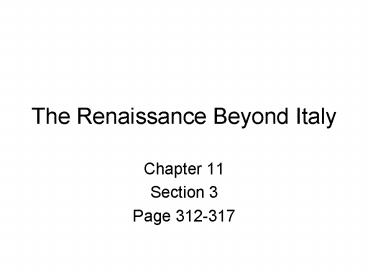The Renaissance Beyond Italy - PowerPoint PPT Presentation
1 / 14
Title:
The Renaissance Beyond Italy
Description:
Title: Renaissance in Northern Europe Author: ccarlson Last modified by: Paul Bleier Created Date: 3/3/2006 5:43:22 AM Document presentation format – PowerPoint PPT presentation
Number of Views:70
Avg rating:3.0/5.0
Title: The Renaissance Beyond Italy
1
The Renaissance Beyond Italy
- Chapter 11
- Section 3
- Page 312-317
2
Renaissance Beyond Italy
Complete Heading!
Complete Heading!
Complete Heading!
3
The Spread of Ideas
Renaissance Beyond Italy
- Europeans admired the Italian focus on wealth,
beauty, and achievement. - Johannes Gutenberg (German) c.1450
- invented movable type printing press
- much faster than hand printing
- By 1500
- about 12 million books in print
- People read
- the Bible
- books by Italian humanists
- By 1550s
- Renaissance ideals a part of northern European
culture
- Why was the printing press an important part of
the Renaissance, Reformation, and Scientific
Revolution?
4
- By 1550s
- Renaissance ideals a part of northern European
culture - Students came to Italian Universities
- learned humanist ideals
- took humanist values home with them
- Italian Women
- studied but only at home
- married into families across Europe
- spread Renaissance ideas
- How did the ideas of the Italian Renaissance
spread across Europe?
5
Ideas and Ideals
Italian Women studied but only at
home married into families across Europe spread
Renaissance ideas
- How did feudalism in northern Europe make the
character of the Renaissance different in the
north than in Italy?
Northern Europe feudal states rulers
patronsnobles royalty learning centered on
royal courts fewer large towns church had more
active role continued to believe in spiritual
also studied Hebrew
Southern Europe (Italy) city-states rulers
patronspatrician families learning centered on
homes of great families larger cities valued
life on earth, here and now more secular,
non-religious - studied Roman Greek humanism
6
continued to believe in spiritual also studied
Hebrew
more secular, non-religious - studied Roman
Greek humanism
- Both began to question traditional church
customs. - Christian Humanism
- focused NOT on Greece Rome but the history of
Christianity - combination of humanist religious ideas
- felt that the Roman Church was corrupt
- called for Church reform
- Desiderius Erasmus (Dutch) thought
- everyone should be able to read Bible
- believers not rely on services in Latin
- church teaching should be understandable
- criticized corrupt clergy in book
In Praise of
Folly - wanted to rid Church of meaningless rituals
- How did the scholar Erasmus represent northern
humanism?
7
More Achievements
- Desiderius Erasmus (Dutch) thought
- everyone should be able to read Bible
- believers not rely on services in Latin
- church teaching should be understandable
- criticized corrupt clergy in book
In Praise of
Folly - wanted to rid Church of meaningless rituals
- Northern European Artists
- did not paint everyone to look like Greek Gods
- painted realistic people with flaws
- painted scenes from everyday life
- Albrect Dürer (artist/painter)
- great detail in his paintings
- most famous for The Four Horsemen
of the Apocalypse - Miguel de Cervantes (writer)
- wrote in the vernacular (common language)
- most famous for Don Quixote
- made fun of nobles and ideas of Middle Ages
- How were northern artists different than Italian
artists?
8
Achievements
- Describe some of the achievements of the northern
Renaissance.
- Artists painted more realistically.
- Writers wrote about religion, politics, and human
behavior. - Scientists made important discoveries.
- Thomas More wrote Utopia and said
- all men should be treated equally.
- William Shakespeare (English)
- created real characters
- Paracelsus (Swiss)
- gave poison to destroy disease
- Ambrose Pare (French)
- created bandages
- used thread instead of burning to close wounds.
9
Summary Task
- Write 3 to 5 good, complete sentences that
describe (in general) what exactly Lesson 4 is
about.
10
The Four Horsemenof theApocalypse byAlbrect
Drüer ( a woodcut woodblock print )
11
Return of the Hunters Pieter Brueghel
12
(a scene from) Don Quixote byMiguel de
Cervantes ( famous phrasetilting at windmills
)
13
William Shakespeare (playwright)
(perhaps) most famous for Romeo Juliet
14
JohannGutenbergc.1440































